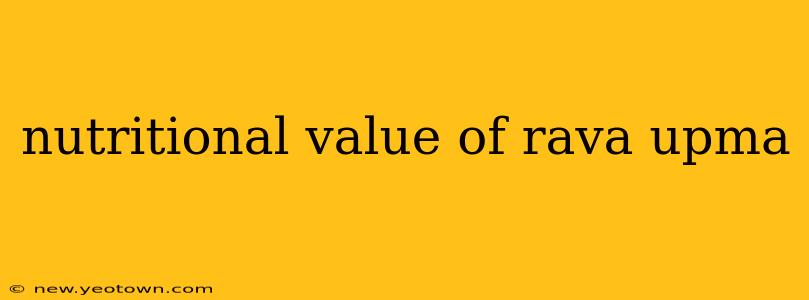Rava upma, a beloved South Indian breakfast, is more than just a tasty dish; it's a nutritional powerhouse packed with essential vitamins, minerals, and energy. Its simple preparation and versatility make it a favorite across many households, but understanding its nutritional profile allows us to appreciate it even more. Let's delve into the delicious details and uncover the hidden nutritional gems within this seemingly simple dish.
What are the main ingredients of rava upma and their nutritional benefits?
The foundation of rava upma rests on semolina (rava), a coarse flour made from durum wheat. This provides a good source of carbohydrates, offering sustained energy throughout the morning. Beyond the rava, the nutritional value significantly expands based on the added ingredients. Vegetables like carrots, beans, peas, and onions contribute essential vitamins and minerals, while the addition of spices like mustard seeds, curry leaves, and chili peppers provide antioxidants and flavor. Furthermore, the use of nuts or roasted peanuts can elevate the protein and healthy fat content.
Is rava upma good for weight loss?
This is a question frequently asked by health-conscious individuals. The answer isn't a simple yes or no. While rava itself is a source of carbohydrates, the overall caloric content of upma depends heavily on the additions. A smaller portion of upma, made with plenty of vegetables and minimal oil, can be part of a balanced weight-loss diet. However, a large portion laden with ghee or coconut oil will contribute significantly to daily caloric intake, potentially hindering weight-loss efforts. The key is moderation and mindful ingredient choices.
How many calories are in a bowl of rava upma?
The calorie count of rava upma is highly variable. A small bowl of vegetable-rich upma prepared with minimal oil might contain around 200-250 calories. However, the addition of ghee, coconut oil, or extra ingredients can quickly increase the calorie count to 300-400 calories or even more. The portion size also plays a crucial role. To manage your calorie intake effectively, it’s best to use a smaller amount of oil and focus on including more vegetables to add volume and nutrients without significantly increasing calories.
What are the health benefits of eating rava upma?
Beyond its energy-boosting carbohydrates, rava upma offers several health benefits depending on its preparation. The vegetables incorporated provide essential vitamins and minerals. For instance, carrots contribute beta-carotene (converted to Vitamin A), crucial for eye health and immunity. Onions offer antioxidants and support cardiovascular health. The spices provide additional antioxidants and contribute to the overall flavour profile. However, it’s important to note that deep-frying or using excessive oil can negate some of these benefits.
Is rava upma good for diabetics?
Rava upma, like other carbohydrate-rich foods, needs careful consideration for individuals with diabetes. The glycemic index (GI) of upma can be moderately high, leading to rapid blood sugar spikes if not managed properly. To make upma more diabetic-friendly, opt for whole wheat rava or add more vegetables to slow down the absorption of carbohydrates. Portion control is also crucial, and it’s best to consult with a doctor or registered dietitian for personalized dietary advice.
Can I eat rava upma every day?
While rava upma is a nutritious and convenient breakfast option, consuming it daily might not be the most balanced approach. Dietary diversity is key to obtaining a wide range of nutrients. Including other breakfast options like oats, idli, or dosa ensures a broader intake of vitamins, minerals, and fibers. However, incorporating rava upma a few times a week as part of a varied and balanced diet is perfectly acceptable.
Conclusion: Enjoying Rava Upma Mindfully
Rava upma, when prepared thoughtfully, can be a nutritious and delicious addition to a balanced diet. By paying attention to portion sizes, minimizing oil usage, and maximizing vegetable inclusion, you can enjoy this flavorful breakfast while reaping its nutritional benefits. Remember, moderation and mindful eating are key to enjoying the goodness of this South Indian staple without compromising your overall health.

